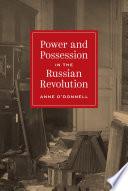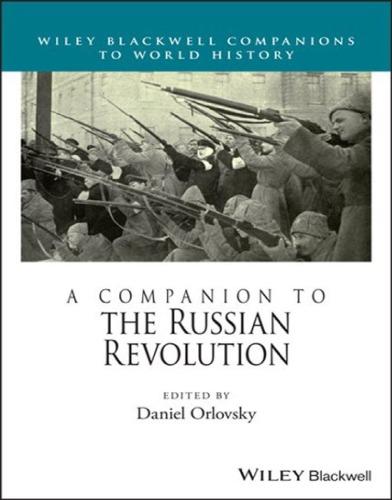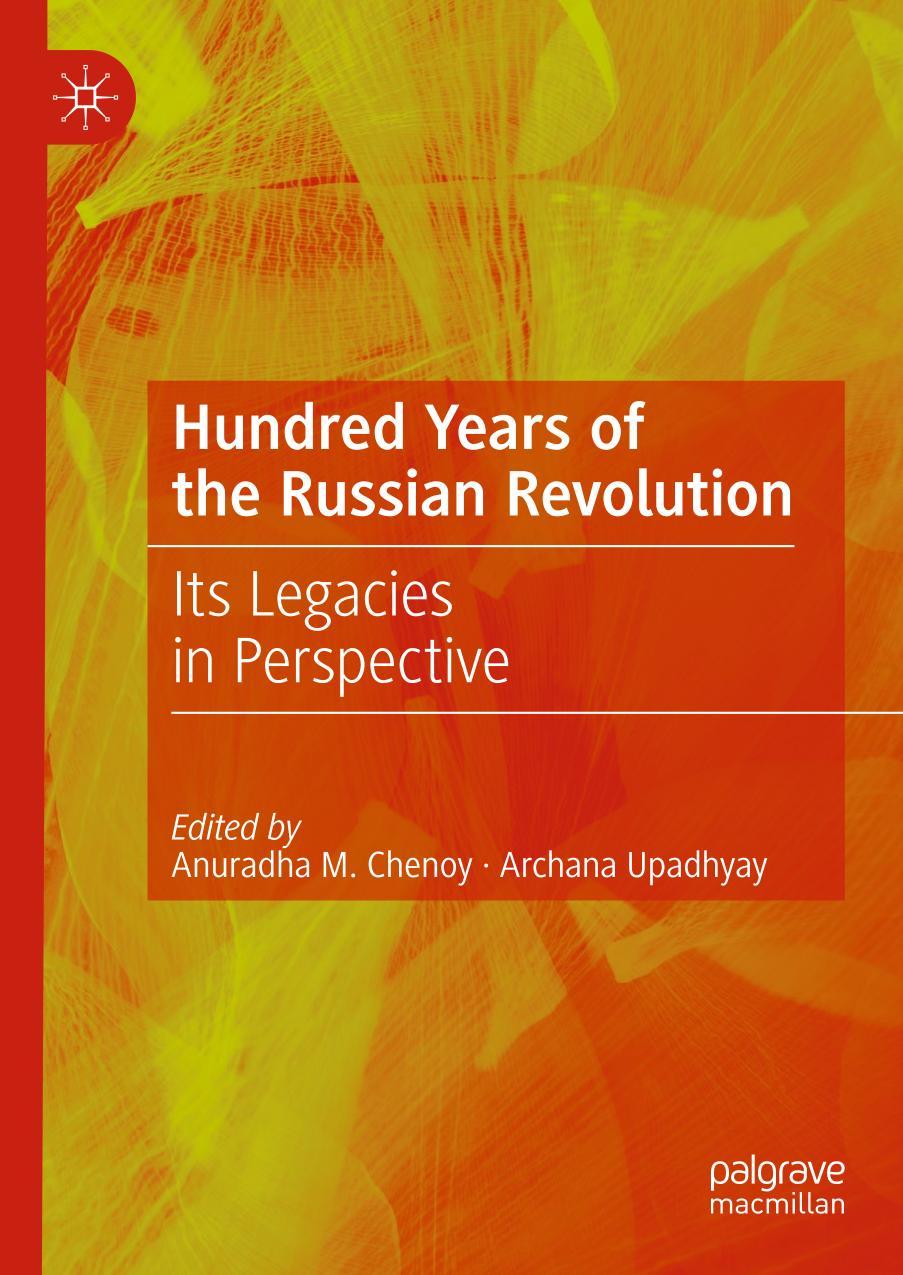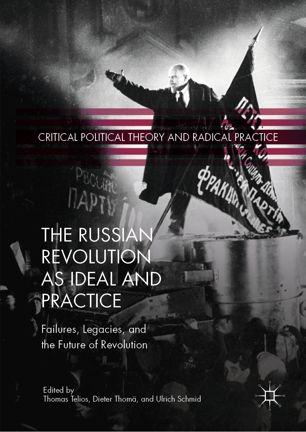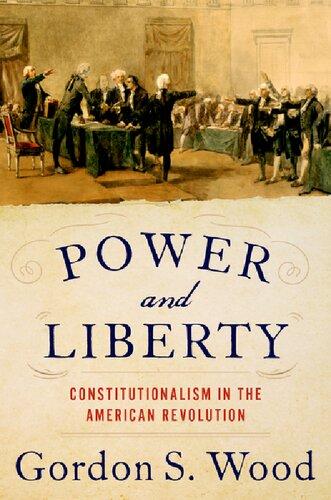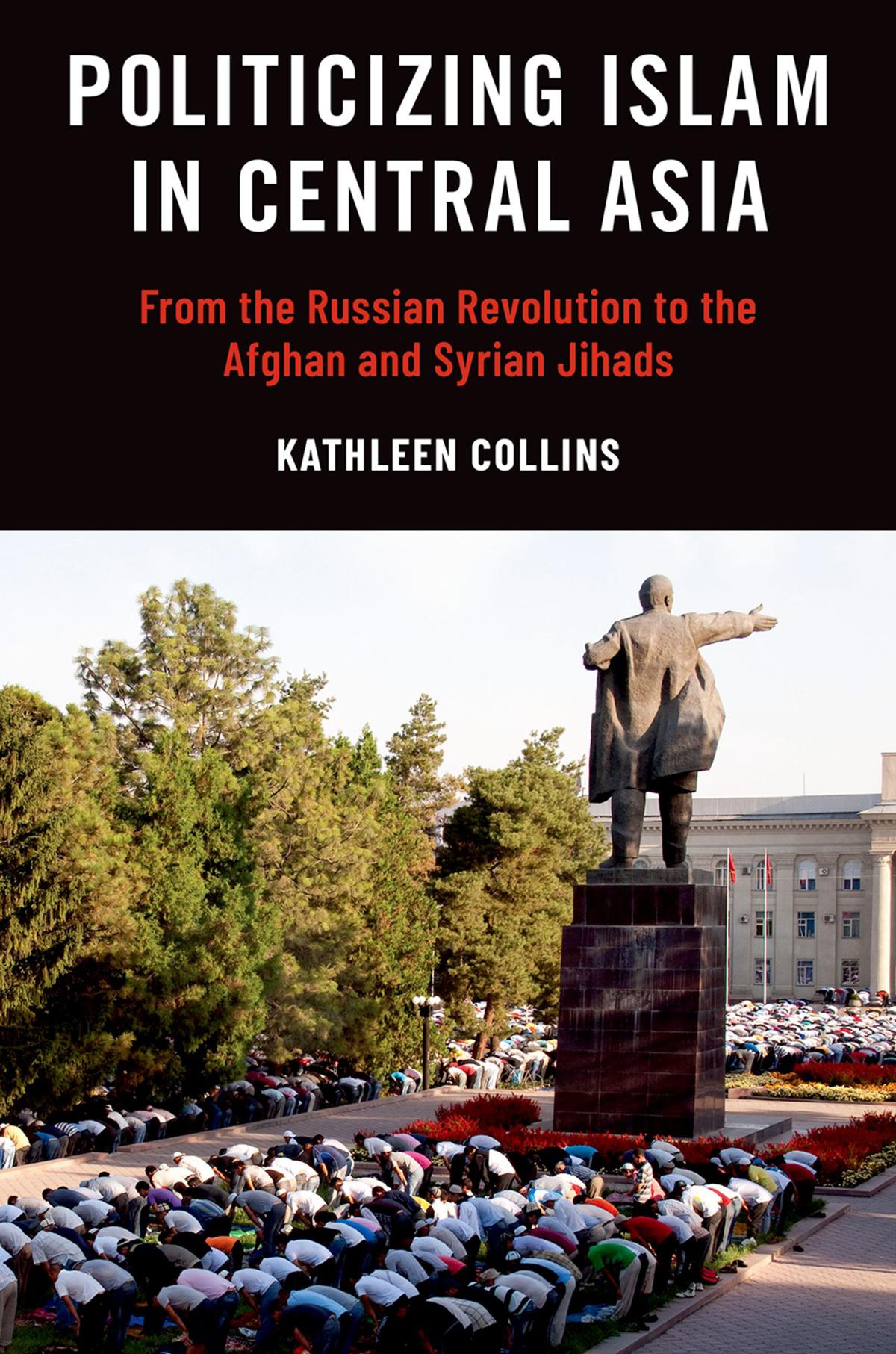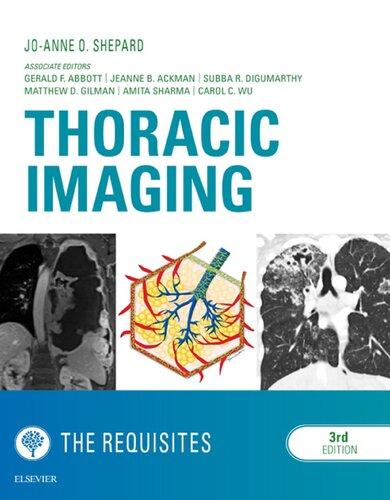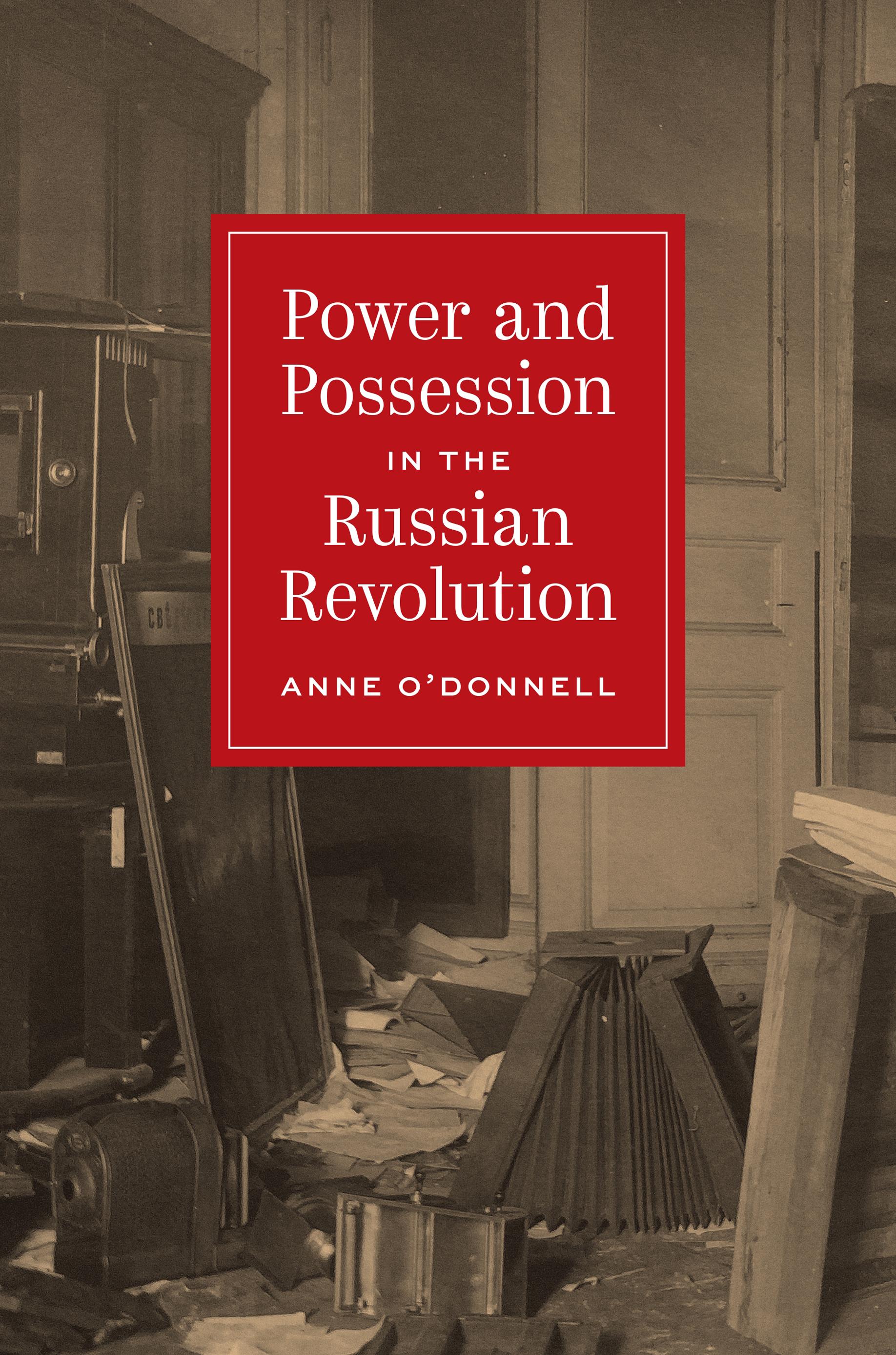Power
and Possession in the Russian Revolution Anne O'Donnell
Visit to download the full and correct content document: https://ebookmass.com/product/power-and-possession-in-the-russian-revolution-anne -odonnell/
More products digital (pdf, epub, mobi) instant download maybe you interests ...
A Companion to the Russian Revolution 1st Edition
Edition Daniel Orlovsky
https://ebookmass.com/product/a-companion-to-the-russianrevolution-1st-edition-edition-daniel-orlovsky/
Hundred Years of the Russian Revolution: Its Legacies in Perspective
Anuradha Mitra Chenoy
https://ebookmass.com/product/hundred-years-of-the-russianrevolution-its-legacies-in-perspective-anuradha-mitra-chenoy/
The Russian Revolution as Ideal and Practice: Failures, Legacies, and the Future of Revolution 1st ed. Edition
Thomas Telios
https://ebookmass.com/product/the-russian-revolution-as-idealand-practice-failures-legacies-and-the-future-of-revolution-1sted-edition-thomas-telios/
Power and Liberty: Constitutionalism in the American Revolution
Gordon S. Wood
https://ebookmass.com/product/power-and-libertyconstitutionalism-in-the-american-revolution-gordon-s-wood/
Politicizing Islam in Central Asia: From the Russian Revolution to the Afghan and Syrian Jihads Kathleen Collins
https://ebookmass.com/product/politicizing-islam-in-central-asiafrom-the-russian-revolution-to-the-afghan-and-syrian-jihadskathleen-collins/
Thoracic Imaging: The Requisites (Requisites in Radiology) 3rd Edition Jo-Anne O. Shepard
https://ebookmass.com/product/thoracic-imaging-the-requisitesrequisites-in-radiology-3rd-edition-jo-anne-o-shepard/
Ben Ali's Tunisia: Power and Contention in an Authoritarian Regime Anne Wolf
https://ebookmass.com/product/ben-alis-tunisia-power-andcontention-in-an-authoritarian-regime-anne-wolf-2/
Ben Ali's Tunisia: Power and Contention in an Authoritarian Regime Anne Wolf
https://ebookmass.com/product/ben-alis-tunisia-power-andcontention-in-an-authoritarian-regime-anne-wolf/
The Boss's Possession Sam Crescent
https://ebookmass.com/product/the-bosss-possession-sam-crescent/
power and possession in the russian revolution
histories of economic life
Jeremy Adelman, Sunil Amrith, Emma Rothschild, and Francesca Trivellato, Series Editors
Power and Possession in the Russian Revolution by Anne O’Donnell
Toward a Free Economy: Swatantra and Opposition Politics in Democratic India by Aditya Balasubramanian
No Return: Jews, Christian Usurers, and the Spread of Mass Expulsion in Medieval Europe by Rowan Dorin
Desert Edens: Colonial Climate Engineering in the Age of Anxiety by Philipp Lehmann
Distant Shores: Colonial Encounters on China’s Maritime Frontier by Melissa Macauley
A Velvet Empire: French Informal Imperialism in the Nineteenth Century by David Todd
Making It Count: Statistics and Statecraft in the Early People’s Republic of China by Arunabh Ghosh
Empires of Vice: The Rise of Opium Prohibition across Southeast Asia by Diana S. Kim
Pirates and Publishers: A Social History of Copyright in Modern China by Fei-Hsien Wang
Sorting Out the Mixed Economy: The Rise and Fall of Welfare and Developmental States in the Americas by Amy C. Offner
Red Meat Republic: A Hoof-to-Table History of How Beef Changed America by Joshua Specht
The Promise and Peril of Credit: What a Forgotten Legend about Jews and Finance Tells Us about the Making of European Commercial Society by Francesca Trivellato
A People’s Constitution: The Everyday Life of Law in the Indian Republic by Rohit De
A Local History of Global Capital: Jute and Peasant Life in the Bengal Delta by Tariq Omar Ali
Power and Possession in the Russian Revolution
anne o’donnell
prince ton university press
prince ton & oxford
Copyright © 2024 by Princeton University Press
Princeton University Press is committed to the protection of copyright and the intellectual property our authors entrust to us. Copyright promotes the progress and integrity of knowledge. Thank you for supporting free speech and the global exchange of ideas by purchasing an authorized edition of this book. If you wish to reproduce or distribute any part of it in any form, please obtain permission.
Requests for permission to reproduce material from this work should be sent to permissions@press princeton edu
Published by Princeton University Press
41 William Street, Princeton, New Jersey 08540 99 Banbury Road, Oxford OX2 6JX
press princeton edu
All Rights Reserved
Library of Congress Cataloging-in-Publication Data
Names: O’Donnell, Anne, 1980– author.
Title: Power and possession in the Russian Revolution / Anne O’Donnell.
Description: Princeton : Princeton University Press, [2024] | Series: Histories of economic life | Includes bibliographical references and index.
Identifiers: LCCN 2023026800 (print) | LCCN 2023026801 (ebook) | ISBN 9780691205540 (hardback) | ISBN 9780691255897 (ebook)
Subjects: LCSH: Right of property— Soviet Union. | Eviction— Soviet Union. | Government ownership— Soviet Union. | Soviet Union—Economic conditions— 1917–1945. | Soviet Union—History—Revolution, 1917–1921—Confiscations and contributions. | BISAC: BUSINESS & ECONOMICS / Economic History | POLITICAL SCIENCE / Political Ideologies / Communism, Post-Communism & Socialism
Classification: LCC DK265.9.E2 O36 2024 (print) | LCC DK265.9.E2 (ebook) | DDC 323.4/60947—dc23/eng/20230728
LC record available at https://lccn.loc.gov/2023026800
LC ebook record available at https://lccn.loc.gov/2023026801
British Library Cataloging-in-Publication Data is available
Editorial: Priya Nelson, Emma Wagh, and Morgan Spehar
Production Editorial: Nathan Carr
Production: Danielle Amatucci
Publicity: William Pagdatoon
Jacket/Cover Credit: The Russian Photographic Society, c. spring 1921.
Photograph taken by B.N. Maklakov. Courtesy of TsAGM
This book has been composed in Arno
Printed on acid-free paper. ∞
Printed in the United States of America
10 9 8 7 6 5 4 3 2 1
For my mother
They saw the spectre of socialism and became afraid; nor is this surprising, for they have something to lose, something to be afraid of. But we are not in that position at all . . .
Europe is sinking because it cannot rid itself of its cargo—that infinity of treasures . . .
In our case, all this is artificial ballast; out with it and overboard, and then full sail into the open sea!
alexander herzen
2
3
4
illustrations and tables
Illustrations
1.1. Vladimir Bonch-Bruevich and Vladimir Lenin explore the Kremlin, 1918 76
2.1. Lubyanka Headquarters of the Cheka as it appeared before the Revolutions of 1917 111
3.1. Inspection form from the Housing Department of Gorodskoi Neighborhood, Moscow c. 1921 170
4.1. No. 3 Nastasinsky Lane, home of Gokhran from 1920 197
4.2. People’s Commissar of Foreign Trade, Leonid Krasin 217
4.3. Plenipotentiary to Gokhran and executioner of the imperial family, Yakov Yurovsky 218
6.1.–6.2. Interior, The Russian Photographic Society, c. spring 1921 (2 images). 282
6.3. “The Housewarming (Workers’ Petrograd)” by Kuzma Petrov-Vodkin (1937) 284
Tables
2.1. “Normal usage of furniture” and acquisition cost in rubles in Petrograd (Prepared Winter 1919) 126
3.1. Per capita housing stock in Moscow, 1915–1925 (Prepared 1925) 151
3.2. Apartments and population per geographic district in Moscow, c. 1912 (Prepared 1919) 156
acknowl edgments
it is a delight to acknowledge the many debts I have accrued in the course of writing this book. I gratefully acknowledge funding for research and writing from the American Council of Learned Societies, the U.S. Department of Education, Harvard University’s Center for History and Economics, the Mellon Foundation, Princeton University’s History Department and Institute for International and Regional Studies, and the Social Science Research Council. A grant from the Prince ton University Press offered through an innovative program for first-time authors was crucial to getting this book over the finish line. I am deeply indebted to the archivists at the State Archive of the Russian Federation, the Manuscript Division at the Russian State Library, the Russian State Archive of the Economy, the Russian State Archive of Socio-Political History, the Russian State Historical Archive, the Central Archive of the City of Moscow, the Central Historical Archive of Moscow, and the Central State Archive of St. Petersburg, all of whom provided impor tant guidance to the papers of a jumbled time, during which standard filing systems did not always obtain.
As it is with great teachers, I will never be able to repay what I owe to Stephen Kotkin. Nevertheless, I register my abiding gratitude here for all he has taught me, for the rigor and empathy he brings to study of history, for his unwavering support, dedication, and optimism. Ekaterina Pravilova taught me new ways of thinking about Russian history and new methods for accessing the history of the material world. She has been an essential interlocutor throughout my work on this book and generously agreed to read several of its chapters. Michael Gordin’s clarity of mind and collegiality have helped me at many turns and I am grateful for his encouragement over the years. At Berkeley, I benefited from seminars with John Connelly, David Henkin, and Yuri Slezkine, who posed questions about Soviet history and what neighbors should expect of one another that left a deep impression. As an undergraduate, I received a summer stipend to work at a nonprofit on the South Side of
Chicago directed by Sokoni Karanja, who suggested a project: that I interview the residents of apartment buildings owned by the city, which the city planned soon to demolish. The questions raised in these encounters continue to guide my research and teaching, and I am deeply grateful to Dr. Karanja for welcoming me into his work. When I returned to school, I enrolled in a one-of-a-kind course on the history of housing and urbanism taught by the late Robert Guttmann, which provided an enriching foundation for my later inquiries.
This book began on Kazakova Street, in the company of an antique dining table that miraculously survived the turmoil described in these pages, and of the family who gathers around it. I am one of many travelers to have found respite in the Zhivovs’ magical apartment; given its inhabitants, I am probably one of many to have found a dissertation topic there. In the best tradition of their parents, Lina Zhivova and her siblings have not only fed and housed me all these years, they have brought me along on their lives. My gratitude to them all is boundless. In the archives, it was a privilege to work alongside so many erudite and welcoming historians, including Seth Bernstein, Miriam Dobson, Sylvain Dufraisse, and James Heinzen. Katja Bruisch shared her capacious knowledge of RGAE as well as her friendship. Juliette Cadiot helped me get my footing intellectually and practically as I began this project, and has been a role model in the art of thoughtful and generous scholarship ever since.
Not everyone wants to spend their twenties in a small town in New Jersey. But in the company of Ryan Davis, Mayhill Fowler, Jamie Kreiner, Kyrill Kunakhovich, Elidor Mëhilli, Dael Norwood, Jamie Reuland, Chris Shannon, and Fadzilah Yahaya, Princeton always felt like a big place, rich with ideas and companionship. At Harvard, I had the good fortune to talk the history of real estate with Alexia Yates, and to absorb the fascinating scholarship on offer at the Center for History and Economics, where Emma Rothschild exercises her unique gift for cultivating scholarly connections across disciplines and fields. I have profited greatly from conversations and conferences with these scholars, at the Center and now in other spaces, especially those organized by Rohit De and Catherine Evans. Seth Bernstein and Elidor Mëhilli generously read drafts of the introduction, each with characteristic lucidity.
At New York University, I have been fortunate to join a thriving community devoted to the study of Russia. Anne Lounsbery and Eliot Borenstein have provided advice, encouragement, and good humor at every step. Thank you to Leydi Rofman for making every thing run smoothly, Alla Roylance for incredible skill and speed in tracking down obscure sources, and Evelina Mendelevich for company. In the history department, Stephen Gross, Monica Kim
acknowl edgments xv (now at Wisconsin-Madison), Tatiana Linkhoeva, Andrew Needham, Susanah Romney, and Andrew Sartori read draft chapters with acumen. Karl Appuhn, Ayşe Baltacıoğlu-Brammer, Jane Burbank, Rossen Djagalov, Stef Geroulanos, Becky Goetz, Ilya Kliger, Yanni Kotsonis, Kim Phillips-Fein (now at Columbia), and Brandon Schechter served as sounding boards, suggested readings, and posed questions that sharpened my thinking. Robyn d’Avignon did all this and more; her camaraderie, wisdom, and careful readings of much of this book have been invaluable.
This book has benefited from the opportunity to present it at a number of institutions and other forums. I spent a fruitful month as a visiting scholar at the École des hautes études en sciences sociales, where I benefited from seminars with Juliette Cadiot, Sabine Dullin, and Alessandro Stanziani. For invitations and enjoyable visits over the years I am grateful to Jeff Hardy, Charis Marantzidou, Stephen Norris, Benjamin Schenk, and Melissa Stockdale, and to audiences at Brigham Young University, the Miami University of Ohio, The University of Oklahoma, the Penn Economic History Forum/Russian History and Culture Workshop, Georgetown University, and Sciences Po. Conversations at these and other meetings with Rachel Applebaum, Betty Banks, Xenia Cherkaev, Franziska Exeler, Anna Ivanova, Boris Kolonitskii, Eric Lohr, Clara Mattei, Liudmila Novikova, Alex Oberlander, Bhavani Raman, Aaron Retish, and Anna Safronova stimulated new ideas about the entangled histories of revolution, law, and economic life. Michael David-Fox and Peter Holquist offered incisive critique and useful suggestions at the very earliest presentations of my research, and have continued to do so on many occasions in all the years since then. Trevor Perri brought an ideal balance of rigor and sensitivity to this manuscript, and I am grateful for his clarifying interventions. I am grateful to the incredible staff at Princeton University Press, not just for bringing this book to fruition, but for supporting my work on it in so many different ways. Priya Nelson steered the manuscript through every stage of this process with an awe-inspiring combination of intelligence and skill. Emma Wagh has kept the manuscript, and me, in line with enthusiasm and efficiency. I am grateful to Nathan Carr for guiding production, and especially for matching this text with Anna Badkhen, whose skill in improving it has been matched only by her good humor. My thanks are due to the two anonymous readers of the manuscript, for their thoughtful engagement with this work. I am grateful to all the series editors for the confidence they showed in the manuscript, especially Emma Rothschild, who shepherded it through the first steps, and Jeremy Adelman, who offered clarifying advice when I most needed it.
April Williams made it possible for me to write this book, taking care of my children with skill and superhuman reliability amid a global pandemic. My thanks to Neva Durand, Charlotte Walker- Said, Johanna Winant, and Alexandra Shaw for their companionship in writing and life, and to Chris and Jay LeGore, Judith Grace, and Jeffrey Mabee for making life in Maine the way it is. I am grateful to my family, Chuck and Karen Whisler, Bill Whisler, Carrie Lee, George Lee, Rachel Levy, Catherine Hinman, Francesca O’Donnell, and Nicholas O’Donnell for their constant encouragement and generosity, and especially to Roger Lee, for making Belfast my home, and to my brother Colin, for looking out for me even still. My husband Ben vowed that, if it meant I finished this book even one moment sooner, I did not have to thank him in these acknowledgments. Combined with his steadfast love, encouragement, wit, and the long days he spent alone with our children, this made all the difference. In my wildest dreams I could never have conjured up children as wonderful as Henry and Vivian. I marvel every day at my incredible good fortune to be their mother. This book is for my mother, Gail, who died as I was just beginning it. I could never have started, let alone finished, without her bottomless well of confidence in me, her example of diligence, her joy in our lives together, her curiosity about the world—in short, without her great love.
rus sia adhered to the Julian calendar through February 1918, after which it switched to the Gregorian calendar, which ran thirteen days ahead. The dates given in this book reflect the calendar systems in use at the time. Where a publication or document makes use of both dates, as was common during the transition, I include them, following the practice of giving the Gregorian date followed by the Julian (in parentheses). Transliterations generally follow the Library of Congress system, with the exception of common English versions of Russian proper names.
Institutional Abbreviations
Central Committee Central Committee of the Communist Party
Cheka/VChK All-Russian Extraordinary Commission for the Battle against Counterrevolution and Sabotage; changed in 1918 to the All-Russian Extraordinary Commission for the Battle against Counterrevolution, Speculation, and Abuse of Power
domkom residential building committee
MChK Moscow Cheka
Gokhran State Depository of Valuables, department of Narkomfin
gorprodukt municipal provisioning agency
Goskon People’s Commissariat of Government Control, succeeded by the Worker-Peasant Inspectorate (Rabkrin)
IEI Institute for Economic Research, unit of Narkomfin
kvartkhoz block economic unit; neighborhood-level administrative unit responsible for registry of built space in Moscow
Mossoviet Moscow Soviet of Workers’, Peasants’ and RedArmy Soldiers’ Deputies (subsequently People’s Deputies)
MUNI Moscow Directorate for Real Estate, successor to TsZhZO
Narkomfin People’s Commissariat of Finance
Narkomiust People’s Commissariat of Justice
NKVD People’s Commissariat of Internal Affairs
NKVT People’s Commissariat of Foreign Trade
partkom Communist Party Committee at an enterprise or institution
Petrokommuna Petrograd City Consumers’ Commune, city provisioning body in Petrograd
Petrosoviet Petrograd Soviet of Workers’ and Soldiers’ Deputies
Rabkrin/RKI Worker-Peasant Inspectorate, successor to the People’s Commissariat of Government Control
RSFSR Russian Soviet Federated Socialist Republic
Soviet raionnykh dum Council of Neighborhood Dumas, municipal administration of Moscow after the February Revolution, incorporated into the Mossoviet in spring 1918
Sovnarkom Council of People’s Commissars
TsZhZO Central Housing-Land Department of the Mossoviet, succeeded by MUNI
VSNKh Supreme Council of the National Economy
VTsIK All-Russian Central Executive Committee
ZhZO Housing and Land Department, unit of a local soviet
Units of Measure
Arshin 2.3 feet or 71.12 cm
Sazhen’ 3 arshins
Desyatina 2,400 sazhens
Funt 0.9 lbs or 409.5 grams
Pood 40 funts
power and possession in the russian revolution
An Infinity of Treasures
in february 1917, the monarchy that had ruled the Russian Empire for three hundred years collapsed. For the next eight months, this empire’s many peoples embarked on a search for freedom and democracy until, at the end of October, the more radical branch of the Russian Social Democratic Party, the Bolsheviks, seized power in the capital city, with the aim of bringing about a global communist revolution. Sometime between these two revolutions, a new language began to be heard in city streets, in shops and offices, markets and homes. 1 Some of the words making up this new language were entirely new: “ sovdep,” to indicate a local institution of government; “ domkom,” for a committee elected by residents of an apartment building to administer it; “narkhoz,” to denote an impor tant new object of governance, the “people’s economy.” Some of the words in this language were familiar, but, as countless newspaper articles, diaries, and memoirs would attest, they were now being used in new ways. Many of the words described different kinds of loss. The simultaneous loss of one’s home together with the movable property inside of it, for instance, was called “eviction” (vyseleniye). “Concentration” (uplotneniye), a technical term formally referring to the density of chemicals and other materials, rather suddenly came to mean the packing of an apartment with additional residents. “Valuables” (tsennosti), in addition to its general meaning, now specifically denoted a material object that was made of precious gems or metals but which lacked an ineffable quality that would elevate it to the level of “art.”
The new lexicon grated on the ears of Moscow’s feuilletonists, who mocked it in their last columns before the Bolshevik government shuttered their newspapers for good.2 But in truth, even the people who embraced the language sometimes found it vexing. “ These are sharp sounds, unpleasant for the ear, ‘Goskhran,’ ” a trade official commented on one new institution’s proposed
name at a meeting. His boss, the People’s Commissar of Foreign Trade, curtly informed the group that, in fact, “it will be called ‘Gokhran,’ ” a clarification met by general silence.3 No less an authority than Vladimir Lenin, the leader of the Bolsheviks and of the postrevolutionary state, can be seen diligently working to master and incorporate the new terms. Several weeks after seizing power, Lenin composed a set of “theses” on the fate of urban real estate, in which he proposed the “alienation” of “all (urban) buildings systematically rented out” by their owners. But upon reflection he scratched out, by hand, the prerevolutionary word, “alienation.” In its place, he wrote a new one: “confiscation.”4
These difficulties in no way hampered this lexicon’s explosive spread. People used these words whether they wanted to or not, because they described something new and specific taking place all around them, a process that was not only violent—violence, however unwelcome, already had a place in the language—but more precisely, one that was aimed at dismantling basic features of material life. It was a lexicon of inversion, created to capture the unmaking of property and the hierarchies of social life, law, and political power it sustained, to express the undoing and revaluing of the material world. In short, it was a lexicon of dispossession.
In the weeks and months after Bolshevik revolutionaries seized power in October 1917, they declared themselves and the dissolving state they inherited to be the masters of a dazzling array of resources. Nationalization decrees asserted ownership over major industries, transport infrastructure, and the imperial banking network. Local governments claimed the rights to dispose of every thing that trailed behind, from bakeries and apartments to hats and coats. In the blink of an eye, the revolutionaries asserted themselves as the rulers not only of the land and the people, but also of material things, becoming purveyors-in-chief of Russia’s material wealth. This book is a history of this unprecedented quest to abolish private property and the search for an alternative system of political economy—socialism—that grew out of it. While prerevolutionary ideologies of socialism in Russia and abroad had trained their sights on the abolition of private property rights in land, factories, and other pieces of major infrastructure as the key precursor to socialist development, dispossession in the Russian Revolution burst far beyond these conventional
landmarks, seeping into the nooks and crannies of daily life. It thus subsumed not only great industrial objects of significance to the whole society but also tiny, wholly unproductive ones, of significance to no one but their owners. Revolutionary dispossession therefore bore a double character, as a mechanism for rearranging the building blocks of economic production that, at the same time, held out the promise of rearranging the basic rhythms of daily life and the social relationships that engendered them.
It was in cities where these two aspects of dispossession most sharply collided.5 This book examines the seizure and statization of the immovable and movable properties—buildings and their contents—that organized daily life in Russia’s dense, bustling capitals. A vast confiscatory project was unfolding at the same time in the Russian countryside, where, in the summer of 1917, peasants seized land and estates, sometimes destroying houses; soldiers fighting in the First World War raced home from the front to participate and share in the spoils.6 The war sharply expanded the possibilities for state seizure as well, as first the tsarist government and then its short-lived successor, the Provisional Government, made new use of “requisition” and “confiscation,” forms of alienation introduced in 1914 to seize the property of enemy aliens, and, eventually, grain from Russian subjects.7 The story told here, rooted in urban property, intersects with these other strands of seizure, while also illuminating distinctive problems in governance and economy connected to the modern city.
The outlines of this story have been dramatized in great works of literature and revolutionary satire. Although the Bolsheviks would quickly go silent on revolutionary dispossession and eschew its memorialization, they were among the first to caricature it. In 1918, Anatoly Lunacharsky, the new Commissar of Enlightenment himself, wrote the script for a film called “Concentration” and cheekily performed an uncredited cameo to boot. The plot was simple, if surprisingly heartwarming given the social conflict at the root of the process: after revolutionary authorities force an elite professor to cede space in his apartment to a working man and his grown daughter, the professor is unexpectedly drawn into their milieu. His younger son falls in love with the worker’s daughter, while his villainous older son is exposed as a class enemy. The socalled communal apartments that resulted from their encounter, and from the hundreds of thousands of other “concentrations” carried out across Russia in real life over the next three years, became enduring symbols of Soviet socialism that were, at the same time, artifacts of how it came into the world— through the redistribution of built space.
I narrate this unmaking of private property in cities during the Revolution across two different stages of “dispossession,” a term I employ throughout the text, together with “seizure,” to indicate the generic act of removing a thing from somebody’s possession. Both the specificity and the politicization of the language of seizure that developed during the Revolution make such a term necessary for distinguishing my analysis of dispossession from the rich lexicon of property-breaking and property-making contemporaries used to characterize it. The first part of the book examines the unmaking of the legal, cultural, and political infrastructure of private property in buildings and movable goods between 1917 and 1920. The seizure and redistribution of people’s homes and belongings came to appear as a natural, indeed essential, element of the transition to socialism. As these chapters detail, however, it was in key respects a surprise—to the revolutionaries no less than the population. The book asks not only how this extraordinary unraveling happened, but also how the revolutionary state sought to remake the seized bounty of the city into a new kind of thing— socialist state property—and to remake itself into a nonmarket proprietor of seized things.
For nearly three years, the seizure of both real estate and movable property occurred largely in the absence of specific, central authorizing laws. But in the spring of 1920, the revolutionary government promulgated its first “Decree on Requisition and Confiscation,” introducing new dynamics of property and power in the Revolution. The second part of the book follows seized things across this divide, as the revolutionary state sought to master its immense material inheritance in the city. These chapters ask how the revolutionaries tried to determine quite literally what there was and what they, as authors of a socialist revolution, ought to do with this trove: how to know and document the material world without the administrative apparatus of private property; how to find the value of material things without markets; and finally, after 1920, how to rebuild bonds of possession without erasing the great transformations that dispossession had wrought.
This story connects the phenomenon of revolutionary dispossession in Russian cities to other episodes of mass dispossession that played out across the twentieth century, both in Europe and beyond it: in the context of communist revolutions, population exchanges, and projects of social extermination. Material dispossession went hand in hand with the cataclysmic violence of these events, yet for much of the century, as one scholar of the Holocaust has written, it attracted comparatively little attention in either public discourse or scholarship, overshadowed by the loss of human life. In Europe, this began
to change in the late 1980s and early 1990s—that is, with the end of Soviet power. The collapse of communism in Eastern Europe triggered a broad reckoning with the two interconnected episodes of dispossession on which the Soviet satellite states were built: of Jews in the Holocaust and of the new subjects of communist rule after the Second World War. The opening up of eastern European states as sites for specific claims of restitution in the 1990s produced a surge of interest in calculating and documenting dispossession on an individual and collective scale, a surge so powerful that it spread even beyond Eastern Europe, to France, Germany, and other western European countries with their own histories of Nazi occupation and collaboration. In all these places, in addition to the work of scholars, government-sponsored reports on the techniques, laws, and experiences of dispossession wielded against Jews and others in the service of “aryanization” began to appear, giving rise to court cases and petitions for restitution that are still wending their ways through the legal system in the present day.8
Paradoxically, the end of the Soviet Union did not have a similar impact on the study of dispossession inside the Soviet Union itself, particularly when it came to the Revolution.9 The reasons for this difference are connected not only to the original conditions of dispossession in Russia and the longevity of the political economy that grew out of it, but also to the frenzied politics of the Soviet Union’s exit from communism. A major stimulus to revisiting the wartime aryanization of property and postwar campaigns of state seizure in the 1990s was, after all, the pursuit of restitution. This stimulus was absent in post- Soviet Russia, where the privatization of state property, for a variety of reasons, did not involve a focus on prerevolutionary claims of owner ship.10
Ten years after the fall of communism in Russia, wrote the Belarusian historian Konstantin Kharchenko at the turn of the twenty-first century, amid the opening of “a great many topics once closed,” there had been no serious opening in the topic of dispossession among scholars in the former Soviet states or abroad. Kharchenko, author of the first and, to date, still one of the few monographs on the topic, attributes this fact to a special reticence around the “property cataclysm” among former Soviet subjects, particularly as it concerned the types of property that are a central interest here—people’s homes and their contents—connected to “the minimal social sanction for the alienation of this form of property” both before and after the Soviet collapse.11 More broadly, as the historian Boris Kolonitskii writes, the “implosion of the communist experiment” dealt a body blow to the study of the Revolution in Russia, tearing down old “interpretive frameworks” and leaving nothing in their place.12
The interpretive emptiness, Kolonitskii contends, allowed the political figures and geopo liti cal fantasies of the Revolution to persist in con temporary Russian political life. In the West, the politics of the collapse were different, but the outcome for the Revolution as an object of study was much the same. “Nothing fails like failure,” the eminent historian of the Revolution Sheila Fitzpatrick mused on the occasion of its centenary, describing the twinned loss of political import and scholarly interest in 1917.13
And yet, whatever the end of Soviet power has meant for the fate of communism, few moments have as much to offer conceptually to the study of the Revolution and the political economy to which it gave rise as does the Soviet collapse. Like the Revolution, the end of communism was attended by profound transformations in the concepts of property, value, and the state; by a vast project to redraw boundaries between public and private spheres that was embedded in material resources; and by the simultaneous labor of building new institutions and a new kind of economy. This book takes inspiration from studies of how the Soviet project unraveled, not because revolutionary dispossession and subsequent “statization” perfectly mirrored the collapse, but rather because, if the political economy of Soviet socialism lived and died as this literature contends, then there are new stories to tell and questions to ask of the Revolution.
My focus is on the fate of property in what was an avowedly socialist revolution, as one of many institutions that revolutionaries associated with capitalism and sought to eliminate in the expectation that eliminating private owners would pave the way to social justice and material abundance. Whether formal or informal, rooted in law or custom, property systems mediate the relationships between people through things. However they are constituted, the legal scholar Carol Rose contends, the most impor tant function of a property system—what separates property from mere possession—is that of enabling “legibility, making clear what belongs to whom,” and why.14 Property systems, that is, do more than bind par ticular people to par ticular things; they are ways of knowing and valuing the material world. They assign certain kinds of powers and rights to things but, more than this, they identify and define who can bear these powers, and to what kinds of things.
After the fall of communism in Eastern Europe, writes the anthropologist Katherine Verdery, every thing about the post- Soviet property landscape appeared “fuzzy.” The fuzziness of this moment sets it apart from other major episodes of dispossession, nationalization, and privatization, in which par ticu lar enterprises, or even entire sectors, moved between state and private
ownership. Here, the relative sizes of the public and private spheres did not merely grow or shrink; the spheres themselves and the division between them had to be wholly reconstituted. The architects of privatization in the 1990s assumed the existence of private landowners and found instead people who continued to limn themselves into collective bodies.15 The would-be objects of property rights were no more distinct. Comprehensive state owner ship had scrambled what were, in the liberal order, conventional boundaries between public and private infrastructure.16 Even physical boundaries turned out to be muddy. In preparation for privatization, it was not uncommon to find the officials of two neighboring institutions pacing the land between their respective buildings, trying to establish where one parcel should end and the other should begin.17
The subjects and objects of a property relationship, then, are not given a priori—they are made. And critically, as this book shows, this was as true for the Soviet state, as the chief bearer of astonishing new powers in material life in the revolutionary era, as it was for private owners at the Soviet collapse. This book thus investigates the seizure and statization of urban infrastructure as, among other things, a process of state-making: of building (or not building) the institutions that would hold and manage the staggering array of material resources nominally flowing into state possession, and of articulating the boundaries within and among these institutions, inside and outside this vast new state domain. As will be seen, the Bolshevik abolition of private property in land and factories triggered a broad cascade of seizure, in some instances decreed by the revolutionary government and in many others not. The speed of dispossession as it ripped through revolutionary society came as a shock to the people who lost things and also to those put in charge of securing, redistributing, and managing them. Dispossession, that is, preceded the existence of a state that could govern it. If this was partly by design on the part of Bolshevik revolutionaries—who welcomed the demise of the “bourgeois” property order and, as need be, its proprietors—it also plunged them, together with the erstwhile proprietors who lost things, and the people who gained them, onto unfamiliar terrain. In eliminating private property in general and dispossessing “bourgeois” owners in par ticular, the Bolsheviks conceived of seizure in the cities as a blow against those private owners, the so-called nonlaboring element, in favor of their opposites, the laboring element. But as this book shows, dispossession did not cease action at the borders of the bourgeoisie or others targeted as enemies of the new order. It ricocheted through Russian society from top to bottom, thrusting losers and winners alike, up to
